The Drawing Arcade
A UX-driven workshop designed to reduce creative barriers for beginner and amateur artists, fostering skill development, confidence, and community through inclusive, guided drawing experiences.

About The Project
This project was developed as part of a senior-level Interaction Design course at Simon Fraser University. Our team collaborated with Draw Around Vancouver (DAV), a grassroots art collective that hosts inclusive weekly drawing events open to people of all skill levels.
The project objective was to observe how participants engaged during these events and identify opportunities to improve the in-person experience, particularly for beginners who might feel hesitant or self-conscious. By combining field observations, interviews, and participatory workshops, we aimed to design solutions that made creative expression feel more welcoming and accessible.
DAV’s mission to challenge traditional ideas of what it means to be an artist resonated deeply with me, and I was excited to help develop a design approach that empowered people to draw freely and confidently.
My Contributions
Our team approached each phase of the project collaboratively, but I found myself contributing more heavily to shaping the research focus and supporting the iterative process to ensure our designs aligned with the client’s goals. I played a key role in organizing and synthesizing user insights, co-developing participatory workshop activities, and maintaining clear communication with our client throughout the project. I particularly enjoyed translating our findings into low-pressure drawing experiences that felt approachable for beginners, drawing on my strengths in empathy and systems thinking.
Team and Timeline
Over the course of three months, our team of six UX researchers and designers worked collaboratively to address key challenges faced by DAV. We began by conducting stakeholder interviews and discovery research, aligned on design goals, and ran iterative testing sessions with community members. By the end of the semester, we had created and validated a set of design interventions that were tailored to DAV’s unique community setting.
Research and Design Opportunities
The project began with a comprehensive discovery phase focused on understanding the ecosystem of local drawing communities. We conducted a competitive analysis and market trend review to assess Draw Around Vancouver’s (DAV) positioning, uncover user needs, and identify key opportunity areas within the community art space. This research laid the groundwork for defining user pain points, experience gaps, and areas for potential innovation.
Ethnographic Observation
We sent a small group from our team to attend DAV events and conduct in-context ethnographic research, focusing on participant demographics, event flow, and behavioral patterns. This approach allowed us to minimize disruption while capturing authentic interactions and behaviors. While I was not part of this group, I contributed to consolidating and interpreting the observational data. These insights helped us identify subtle engagement levels, social dynamics, and moments of friction that informed our design direction.
User Interviews
As part of our interview team, I helped conduct and take notes during sessions with 13 participants, a volunteer, and a facilitator. I also contributed to consolidating the insights into actionable themes that highlighted user motivations, perceptions of DAV, and opportunities for improving accessibility and engagement.
Firsthand Participation
As part of our immersive research, I engaged directly in DAV event activities to better understand the participant journey and emotional context. This firsthand involvement helped shape my perspective on the subtle barriers beginners face when entering community-based creative spaces.

User Insights & Experience Modeling
Leveraging insights from our initial research, we developed detailed user personas and corresponding journey maps to visualize the user experience. Two primary personas emerged: the casual art hobbyist and the progress-driven learner. Each persona was crafted to reflect distinct motivations, goals, and pain points, particularly around accessibility, confidence, and expectations within community-based drawing environments.
User Personas
Creating user personas helped us define key audience segments at DAV events and align our design decisions with the specific goals and needs of each group. I contributed to building our personas by identifying patterns in participant goals and pain points, especially around confidence and social comfort.
Journey Mapping
Using our defined personas as a foundation, we mapped out user journeys from initial discovery of DAV events to post-event reflection. These insights helped us narrow our focus and identify meaningful areas for design intervention. I helped visualize the journey from a beginner’s perspective, mapping moments of hesitation and emotional triggers that often disrupted engagement.
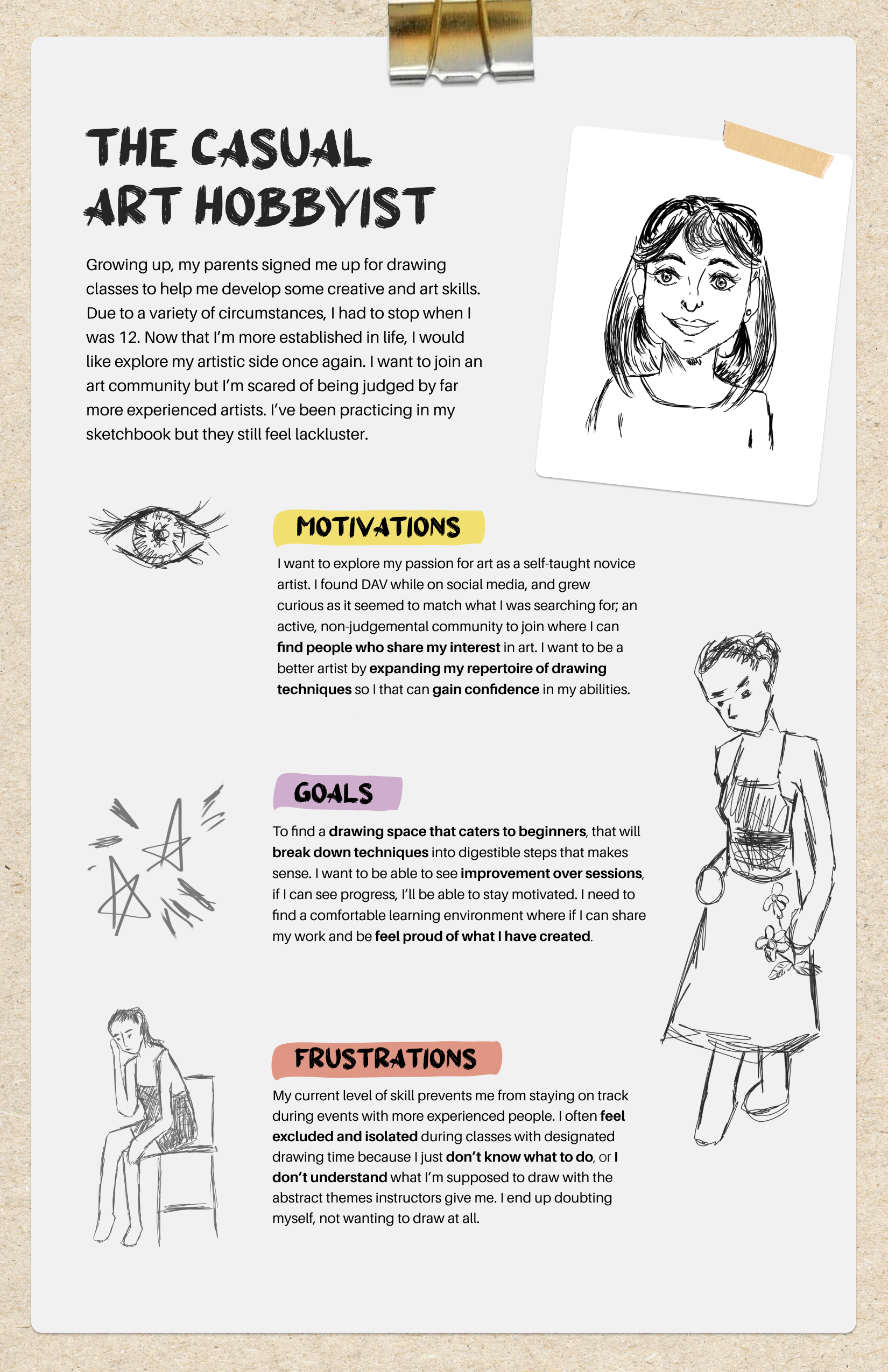
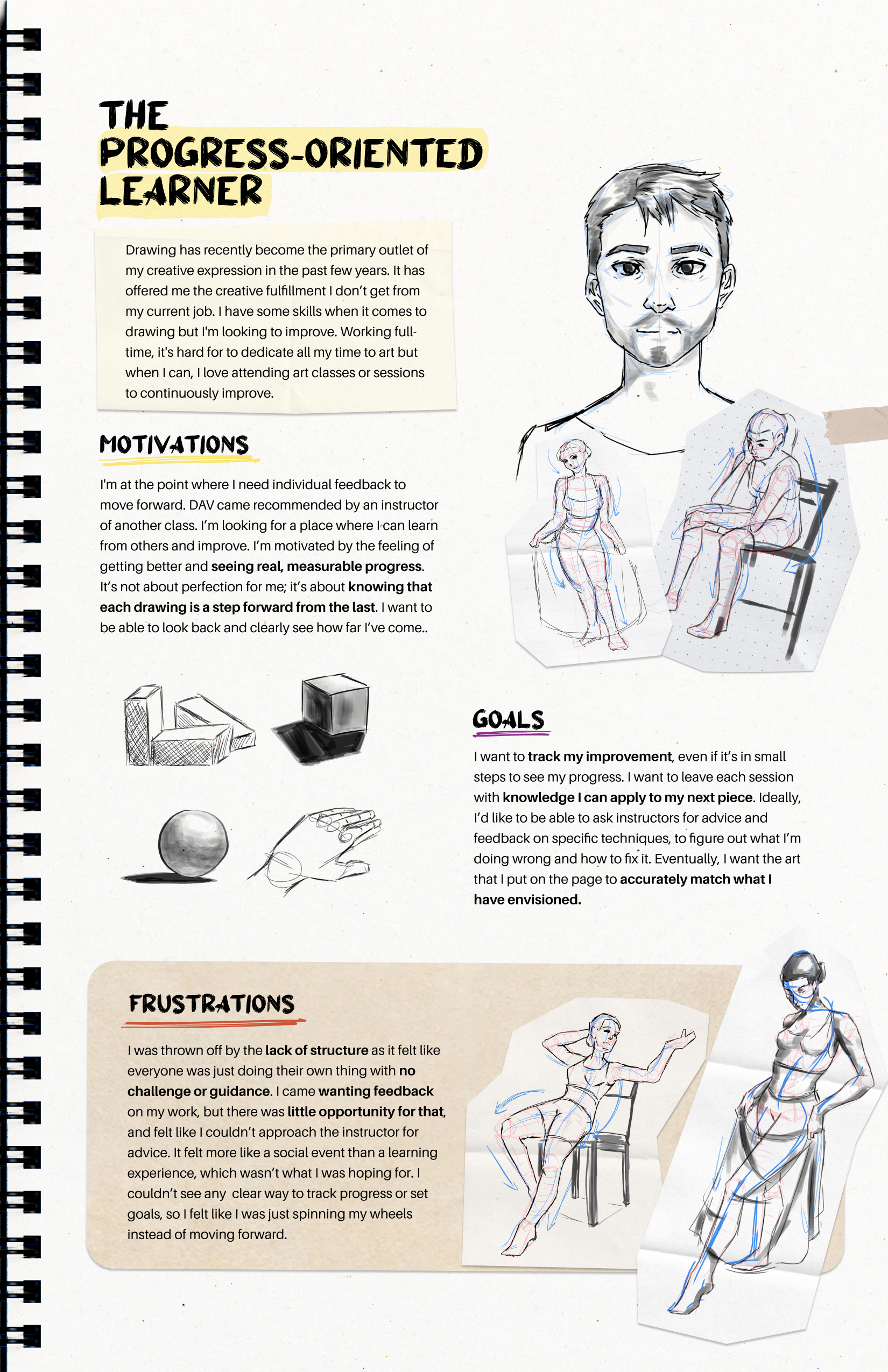
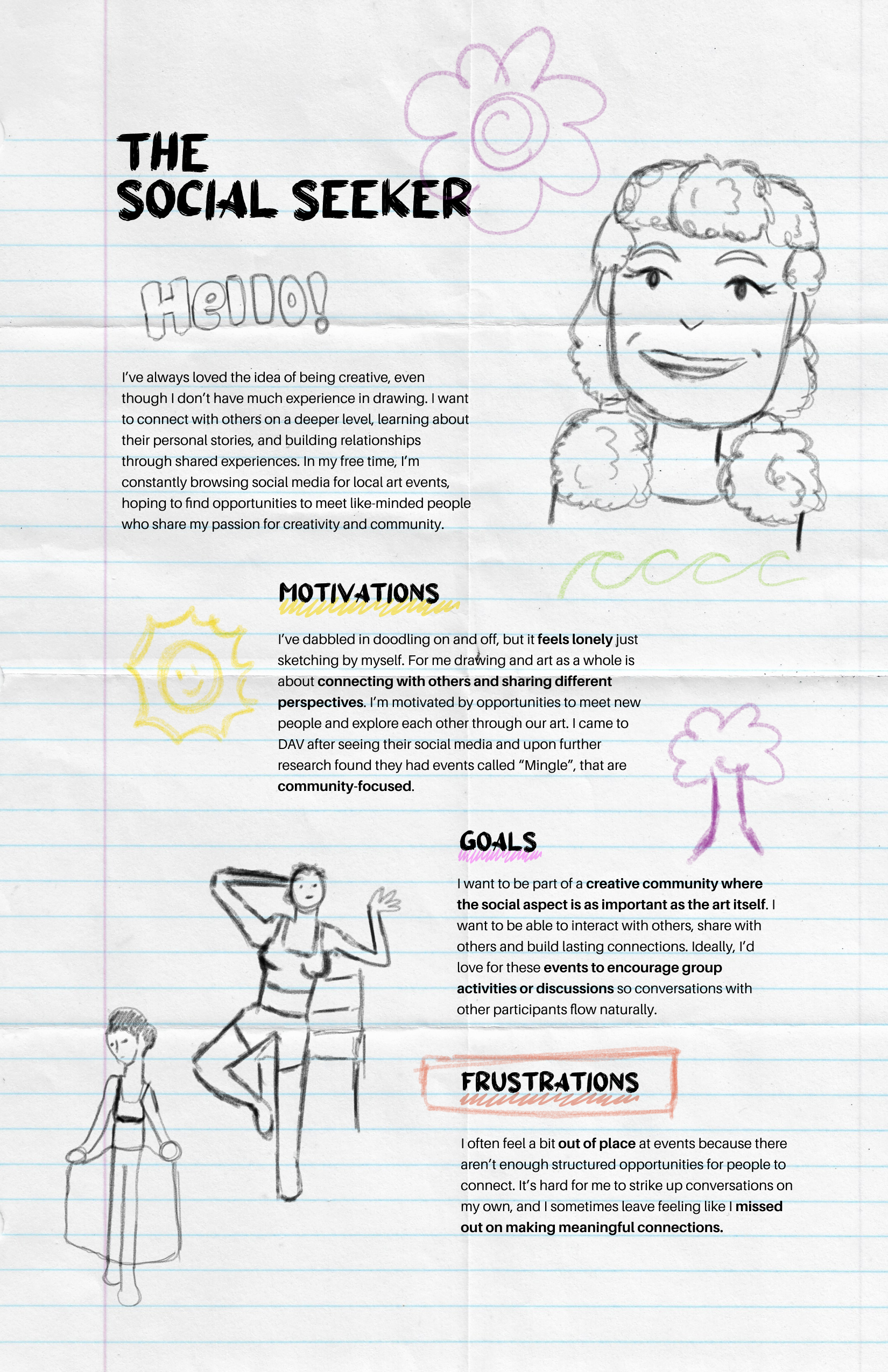
Insights & Strategic Opportunities
Our research surfaced recurring pain points that informed our design direction and highlighted areas with the greatest potential for impact. Key findings include:
-
Structured Learning Opportunities:
Many participants, especially beginners, expressed feeling overwhelmed by DAV’s open-ended and abstract format. The lack of structured learning paths made it difficult for them to build confidence or track progress over time. -
Need for More Community:
Users shared a desire for more opportunities to connect meaningfully with other participants. The current event format lacked activities that foster a sense of belonging, limiting the potential for community-building and peer support. -
Barriers in Retention:
We identified some key obstacles preventing repeat attendance at DAV events, highlighting opportunities to improve long-term user retention and community connection.
Several of these insights emerged through my involvement in the synthesis process and helped guide our focus toward creating a more inclusive and supportive experience for beginner and amateur artists.
Concept Ideation
Building on our research insights, we explored three concept directions to address the needs and pain points of DAV participants:
-
Beginner-friendly Instruction Handbook:
A printed or digital guide designed to help first-time attendees navigate DAV events with confidence. It would include event expectations, tips for getting started, and prompts to encourage participation. -
Community Art Platform:
An online space where participants could share their artwork beyond the event, receive feedback, and stay connected with others. This aimed to extend the sense of community and creative growth outside of in-person sessions. -
Icebreaker Pamphlet:
A toolkit for event facilitators, providing structured, low-pressure activities to help participants interact and build connections. This addressed the recurring need for stronger social engagement and community bonding.
I contributed to the development of the Community Art Platform and Icebreaker Pamphlet concepts by helping shape their content and structure. My focus was on ensuring each idea addressed the social and emotional needs we identified, while aligning with DAV’s inclusive and community-oriented approach.
To evaluate the impact of each concept, we created posters and storyboards that illustrated how they would benefit our two key personas, the Casual Hobbyist and the Progress-Driven Learner, within their respective user journeys.

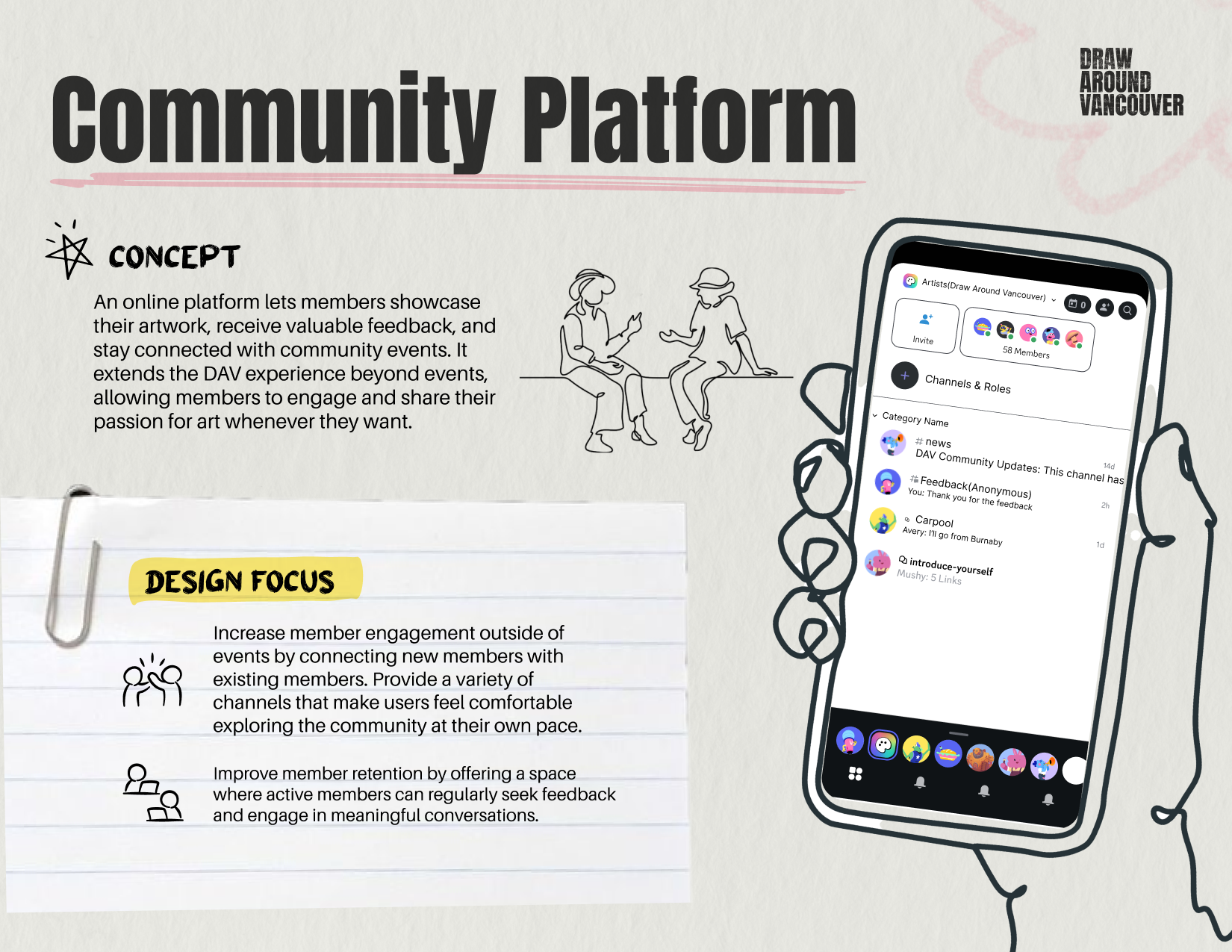
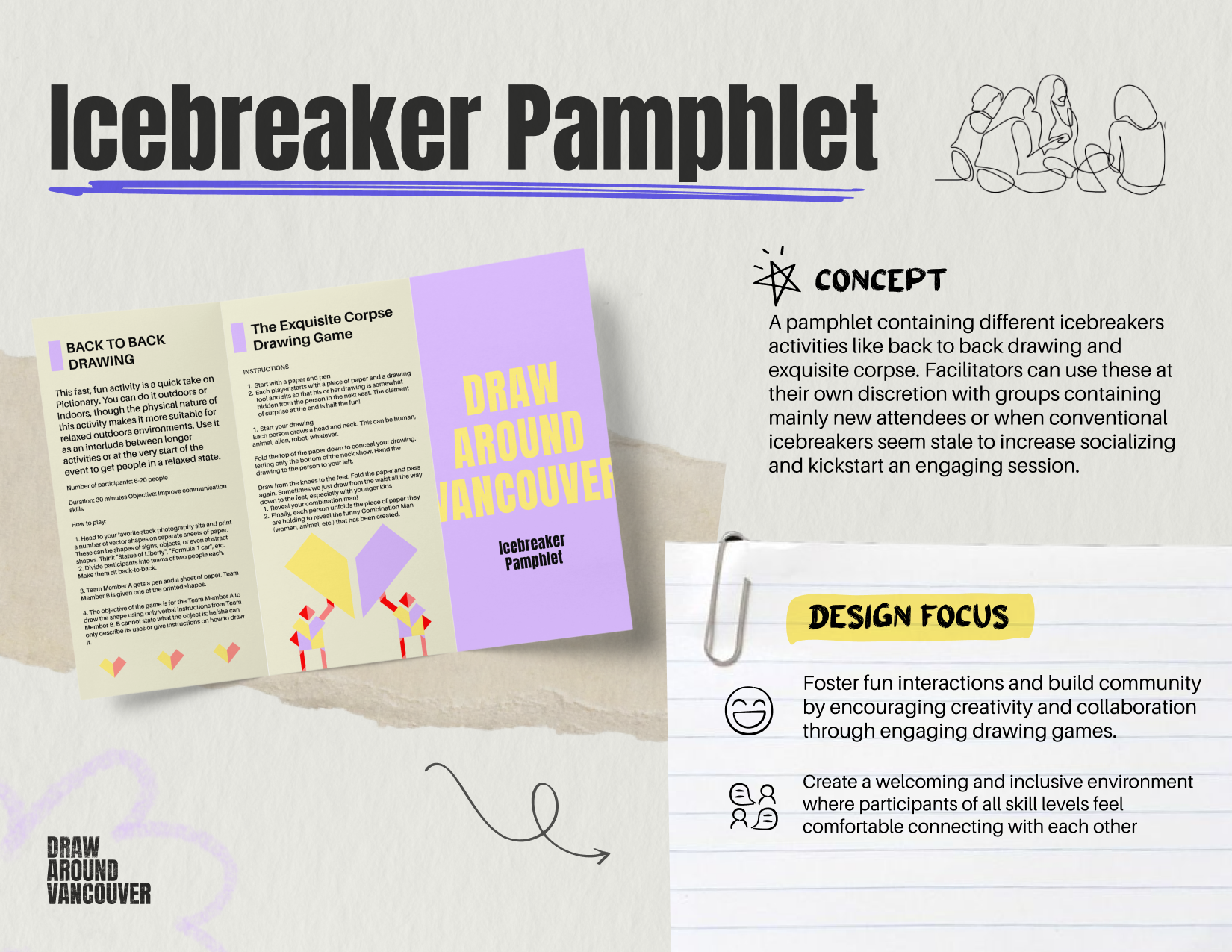
Storyboard Visualizations
To communicate the impact of our concepts across different personas, we created visual storyboards that illustrate how users interact with our proposed solutions during a typical DAV session. I contributed to writing the dialogue featured in the storyboard, helping ensure the tone felt approachable and reflected the personality of each user type.
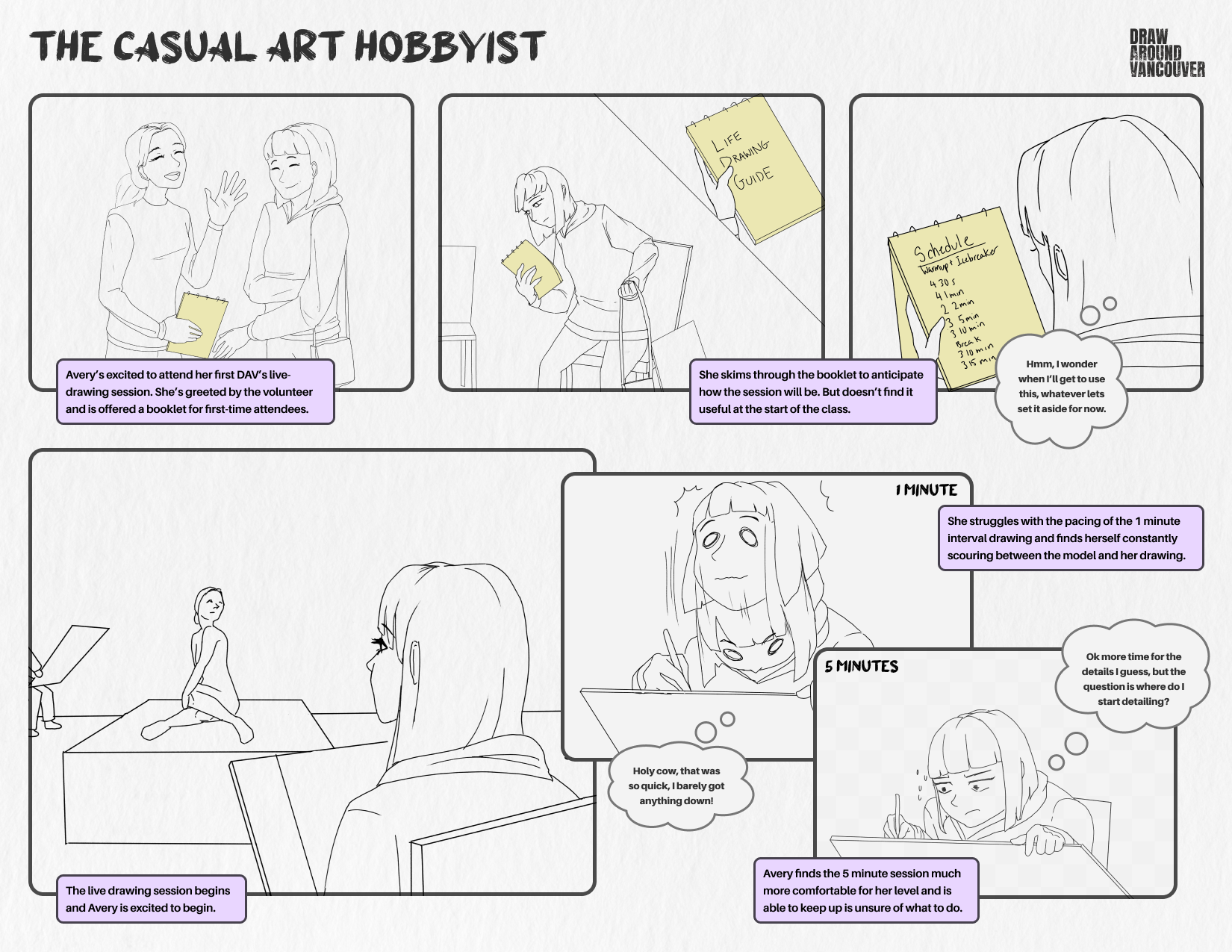
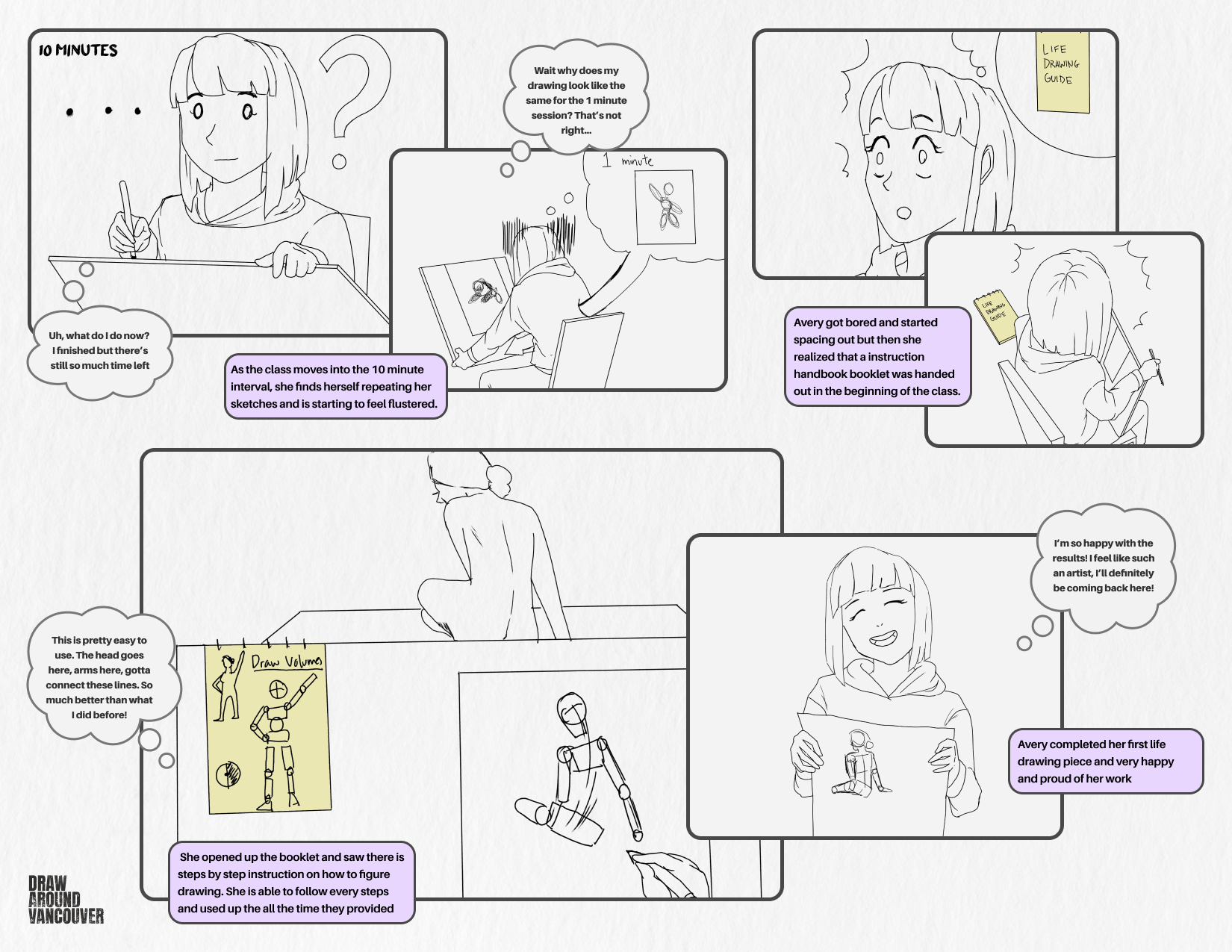

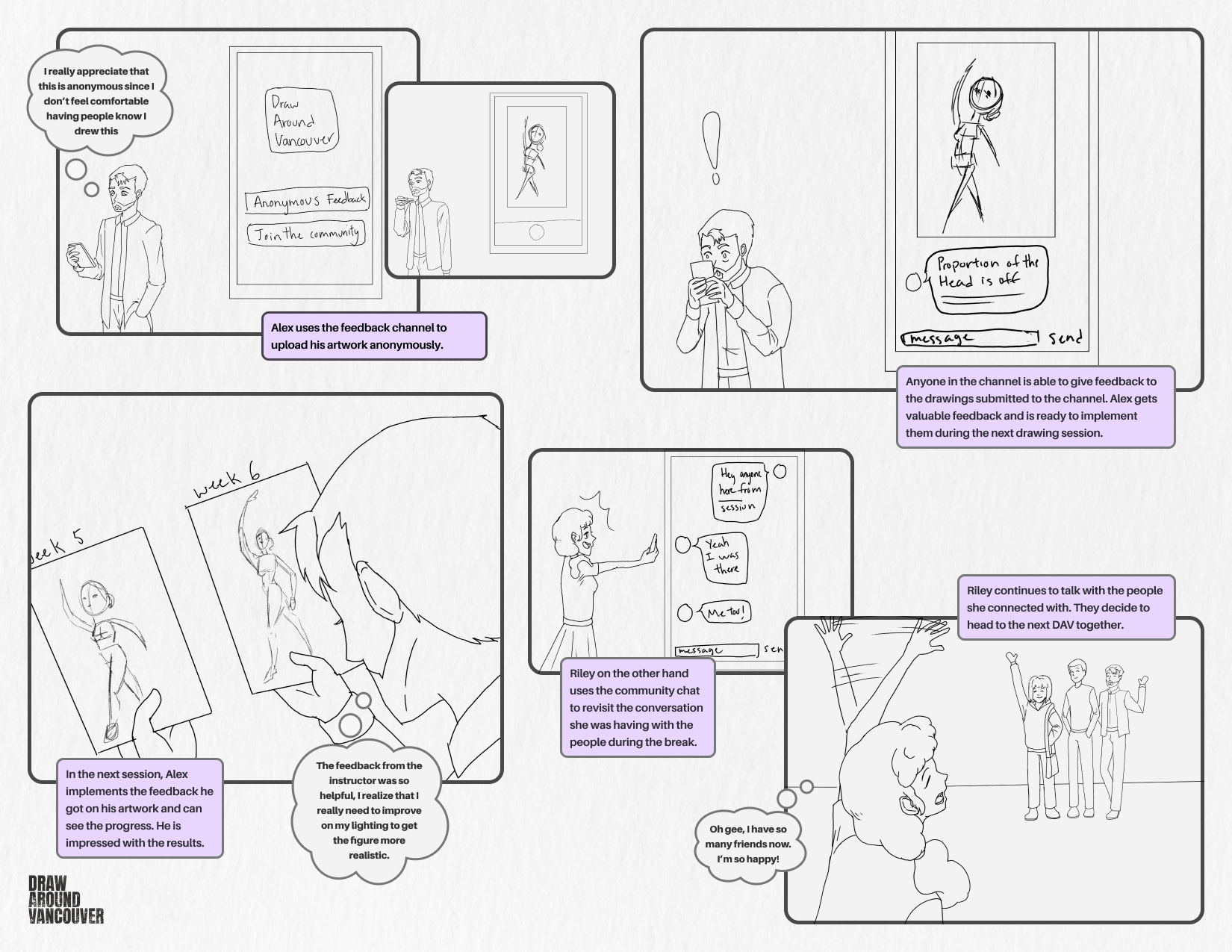
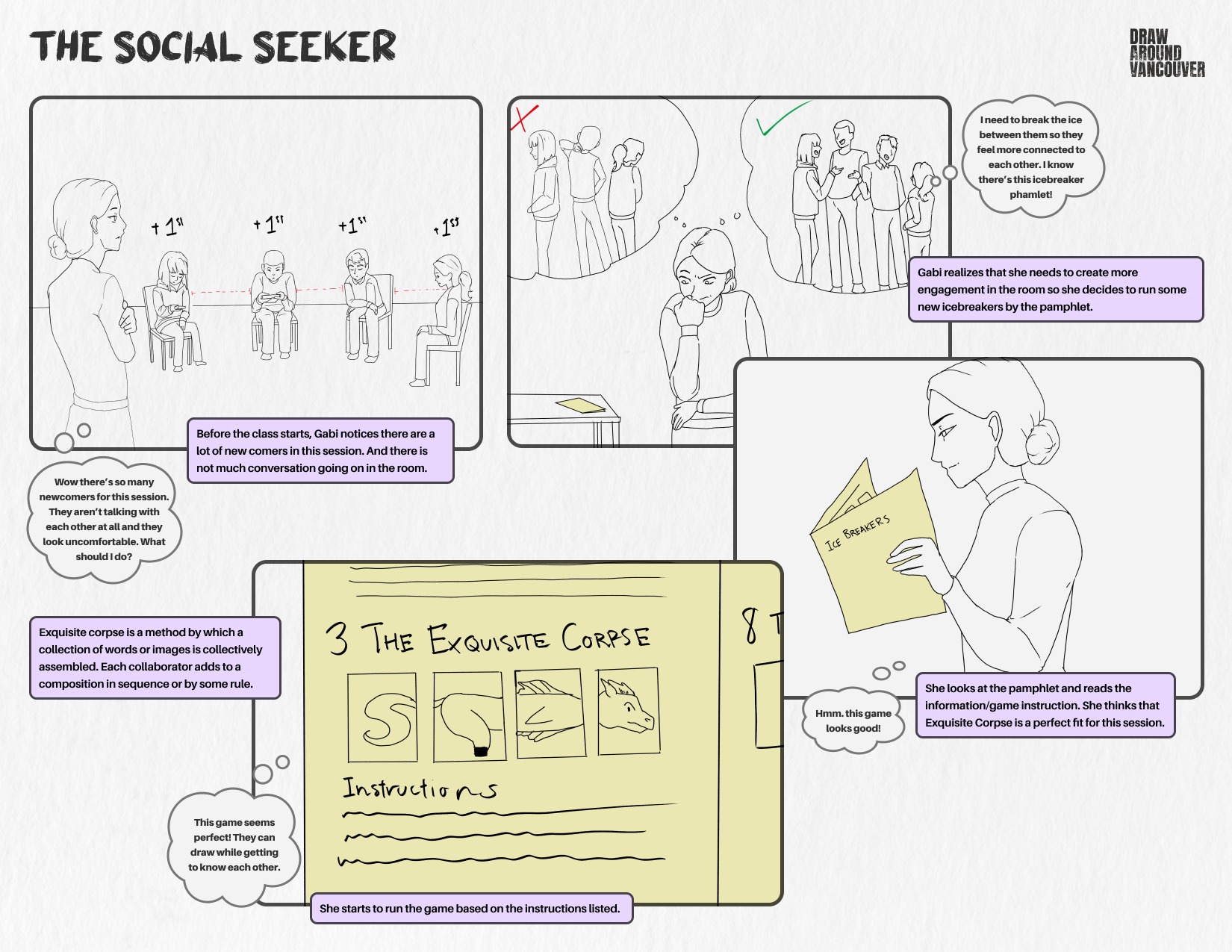

Iterative Design & Testing
Concept Testing & Re-Evaluation
Guided by our research insights, we explored three distinct concept directions: a beginner-friendly drawing handbook, a community platform, and an icebreaker pamphlet. These ideas evolved through continuous user feedback and collaborative discussions with stakeholders, helping us refine and align each concept with both user needs and organizational goals. We began planning a participatory workshop with individuals from diverse drawing backgrounds to test the feasibility of our concepts. I contributed to planning the workshop activities and helped build the stations used to test each idea.
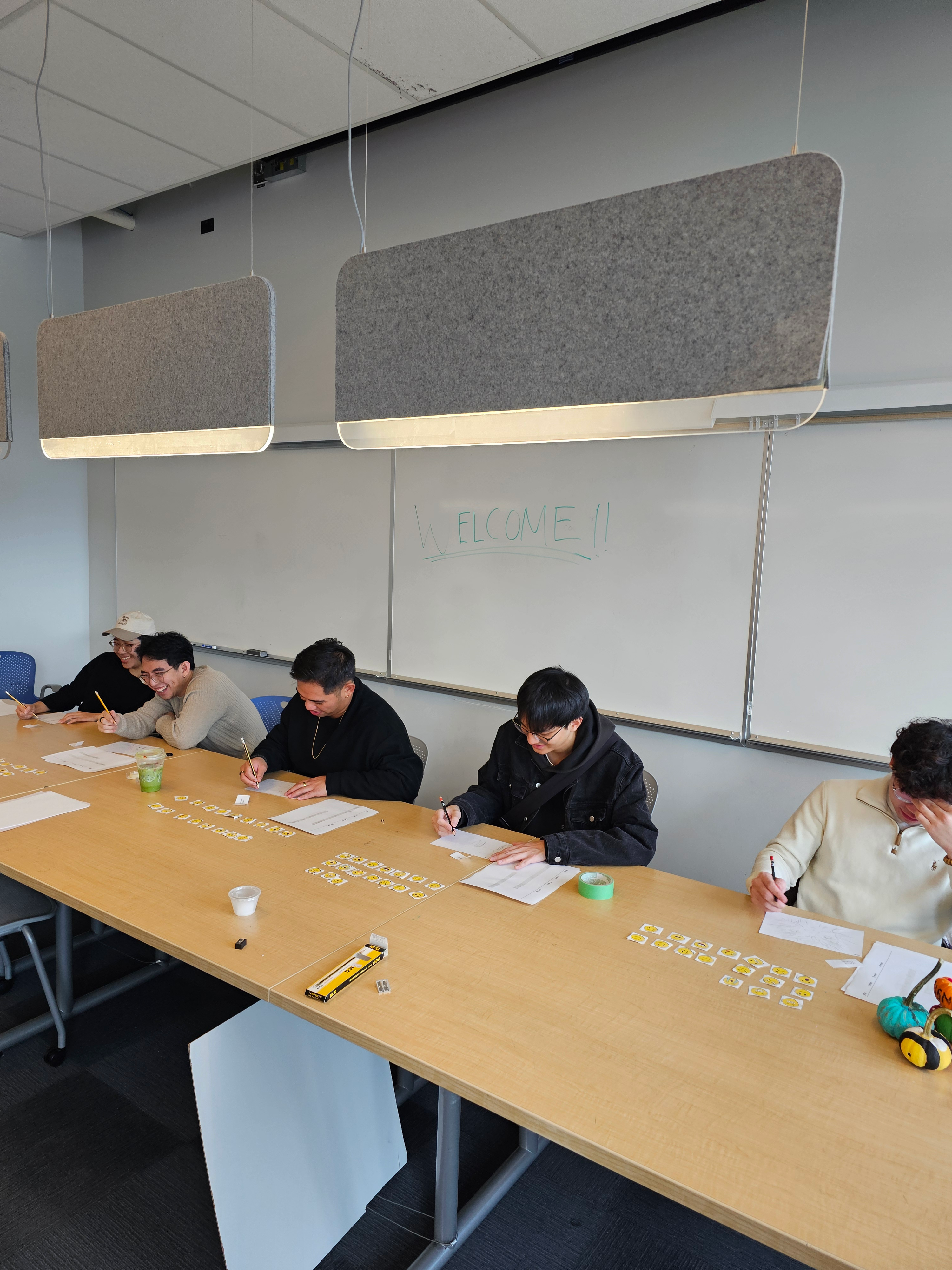
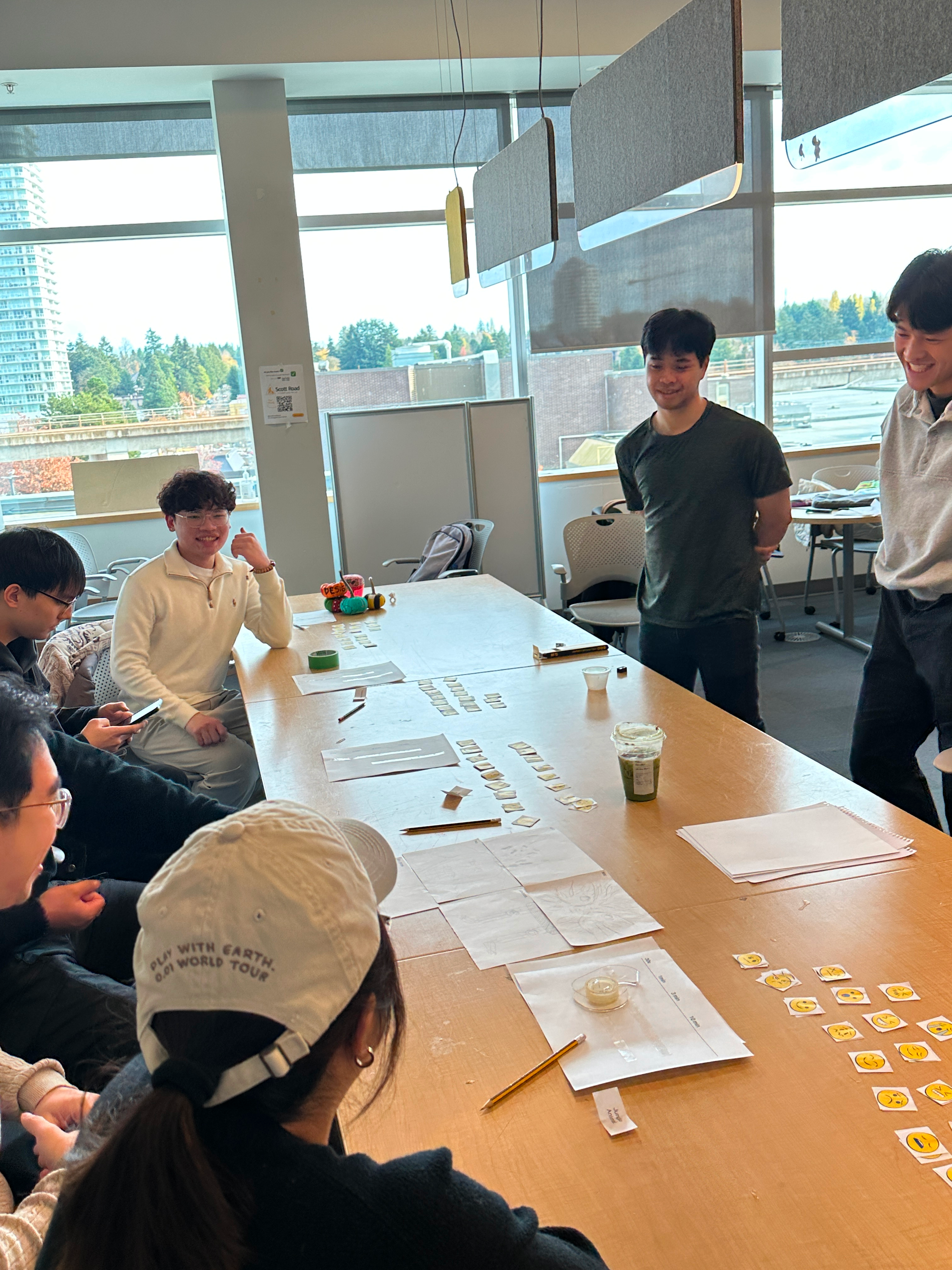
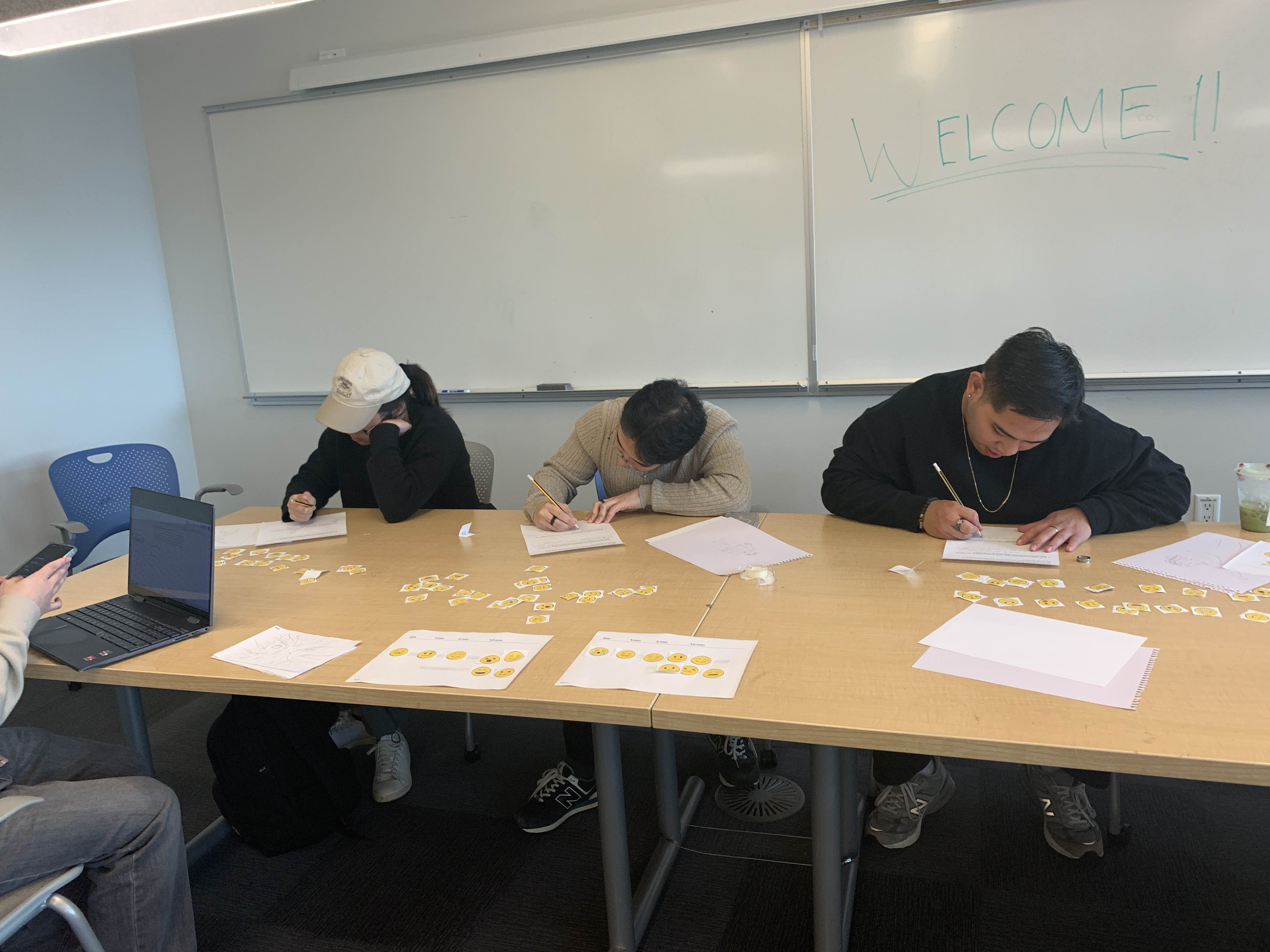
To test and refine our design concepts, we organized 1.5-hour long in-person participatory workshops. This session included people of diverse drawing and art backgrounds. Our goal was to gather rich and multiple perspectives for feedback on the proposed concepts and ensure they aligned with the user needs. Here is the breakdown of the activities and rationale behind them:
- Exquisite Corpse
Description: Each participant receives a blank piece of paper with a designated body part and a thematic prompt. They are then instructed to draw on the paper for 3 minutes without looking at others’ drawings. Once the time is up, the body parts are combined to form a new creature and discuss a name for them.
Rationale: This activity sensitizes beginners to the creative drawing process in a playful, low-stakes way, encouraging collaboration and reducing self-judgement around skill level. It aligns with DAV’s mission of inclusivity, fostering community and setting a welcoming tone for the workshop. - Life Drawing Session
Description: Introduce participants to different intervals of life drawing sessions. Participants are asked to place various emojis they can use to mark their current emotion throughout on a timeline given to them. At the end of the activity they are asked to explain the emojis they placed.
Rationale: The life drawing session immerses participants in the DAV experience, helping us map their emotions and re-confirm the pain points identified in the ethnography research. Using emoji, participants can easily reflect on their feelings during the session and explore emotional barriers to engagement. - Life Drawing Reflection
Description: After the life drawing session, participants are given a worksheet with questions to help them reflect on the experience. They are given 10 minutes to answer with a follow-up discussion to facilitate their generated ideas.
Rationale: Prompt participants to visualize their ideal drawing experience within DAV’s free-drawing structure, encouraging ideas to enhance comfort and engagement. Through reflecting on past struggles, participants can identify strategies to overcome challenges. - Reverse-engineer Drawing Finding
Description: An artwork is shown and participants are asked to observe what stands out in the technique, details, and composition. They are then encouraged to imagine achieving this level of art. An explanation is given about the process of thinking backwards from the goal to identify steps and support needed to achieve it. Prompts are provided to guide discussion:
— What’s the first step needed to get started?
— What support would keep you improving (e.g., demos, feedback)?
— What challenges might arise, and how would you overcome them?
— When near the goal, what would help you feel proud of your progress?
Rationale: Helps participants envision the steps and support needed to reach their artistic goals. By identifying guidance, resources and techniques, they can clarify what would keep them engaged and motivated.
Key Findings
From this workshop, four major themes were highlighted: the need for longer drawing sessions, lack of guidance and references during sessions, a desire for deeper explanation of techniques, and a shared fear of being judged or compared. These findings helped finalize our design direction and ensured that the concepts we developed addressed the real needs of our user base.
User Insight
Continuous feedback from participants helped us zero in on the most meaningful areas for improvement. We used these insights to prioritize features that were both valuable to users and realistic for the team to implement. This iterative, user-centered process was essential in ensuring our final design aligned with participant expectations and DAV’s organizational objectives. I also supported the integration of participant feedback into later iterations, refining key elements of our concepts to better reflect user concerns.
Aligning with DAV
By analyzing comparable drawing communities, we identified clear opportunities to differentiate DAV through its inclusive, low-pressure approach. Our design priorities were chosen to reinforce this unique philosophy, while remaining mindful of the team’s bandwidth and implementation capacity. I was also involved in creating the presentation and documentation materials used to communicate these priorities back to the client.
Project Outcomes
Final Design: The Drawing Arcade
Building on the key insights from our research and testing phases, our team created The Drawing Arcade, an innovative, station-based workshop that reimagines how participants engage with art. Developed through synthesis of user feedback, stakeholder input, and iterative exploration, the workshop was designed to support and inspire artists of all skill levels. I contributed to the planning and setup of the final activity stations, helping translate our tested concepts into hands-on, approachable experiences that reflected the needs of DAV’s community.
My Role in Final Station Implementation
I contributed to the creation of several Drawing Arcade stations by helping plan and assemble the materials used during the workshop. Working closely with the team, I focused on making the activities approachable and low-pressure for beginners, ensuring they reflected our core design values. I also supported the writing and formatting of facilitator instruction posters, aiming to keep them clear and welcoming for both participants and DAV staff.
Station #1: Shape Learning
Primary Activity: Shape Detective
Shape Detective is a facilitator-led activity designed to help participants observe and deconstruct everyday objects into basic, understandable shapes. Participants begin with the Mystery Box Challenge, guessing an object’s shape by touch, followed by simplified sketching with translucent dividers. They are then encouraged to transform their shape-based sketches into imaginative creations.
- Skills: Visual simplification, creativity, tactile perception
- Suggested time: 40–45 minutes


Alternate Activity: Shape the Body Part
This activity guides participants through breaking down human body parts into basic shapes using cutouts and carbon transfer sheets. Participants practice anatomy simplification and redraw based on the simplified shapes. Multiple body parts and optional challenges are available.
- Skills: Anatomical simplification, shape recognition, foundational anatomy
- Suggested time: 30 minutes
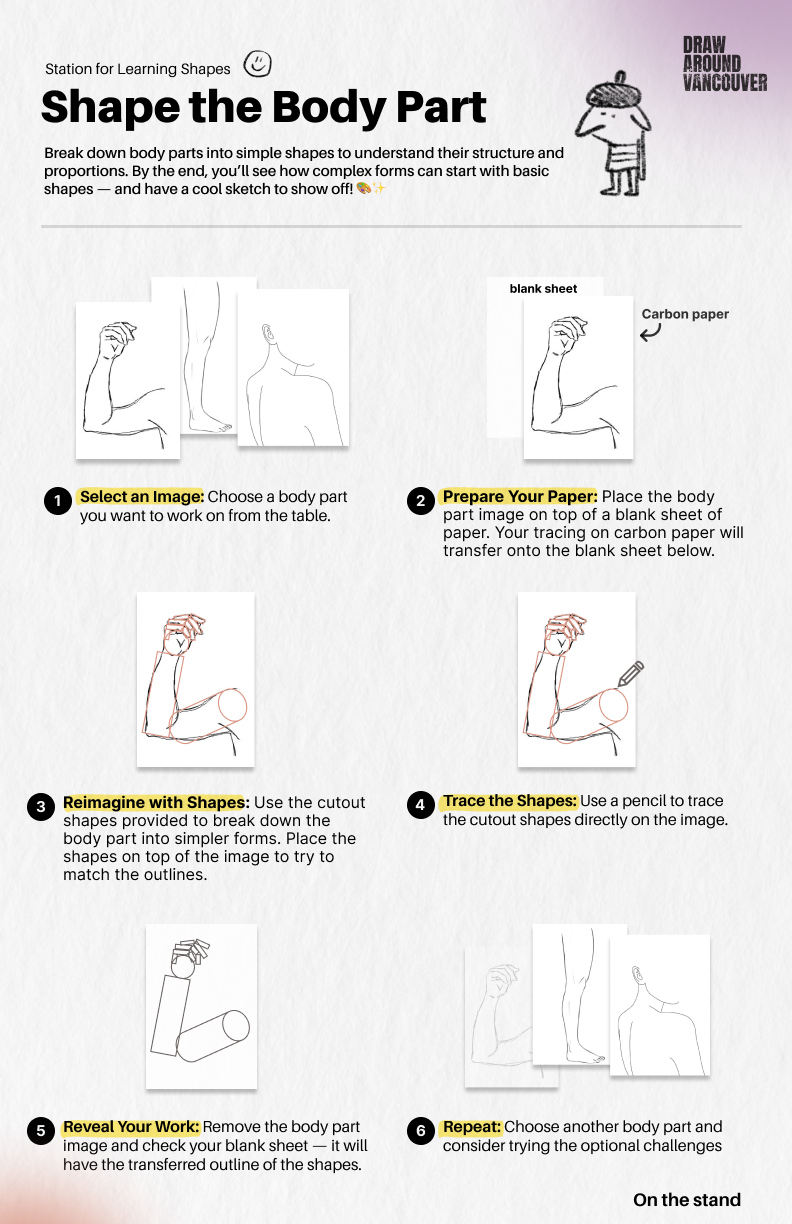

Station #2: Shading
Primary Activity: Light Explorer (Still Life)
This hands-on activity focuses on observing how light interacts with still-life objects and how shadows form based on light direction. Participants move a lamp around a basic object, observe shadow behavior (stretching, shrinking, shifting), and then draw those shadows using reference guides. Emphasis is placed on experimenting with hatching, cross-hatching, scribbling, and smudging.
- Skills: Shadow observation, light placement, shading technique
- Suggested time: 30 minutes
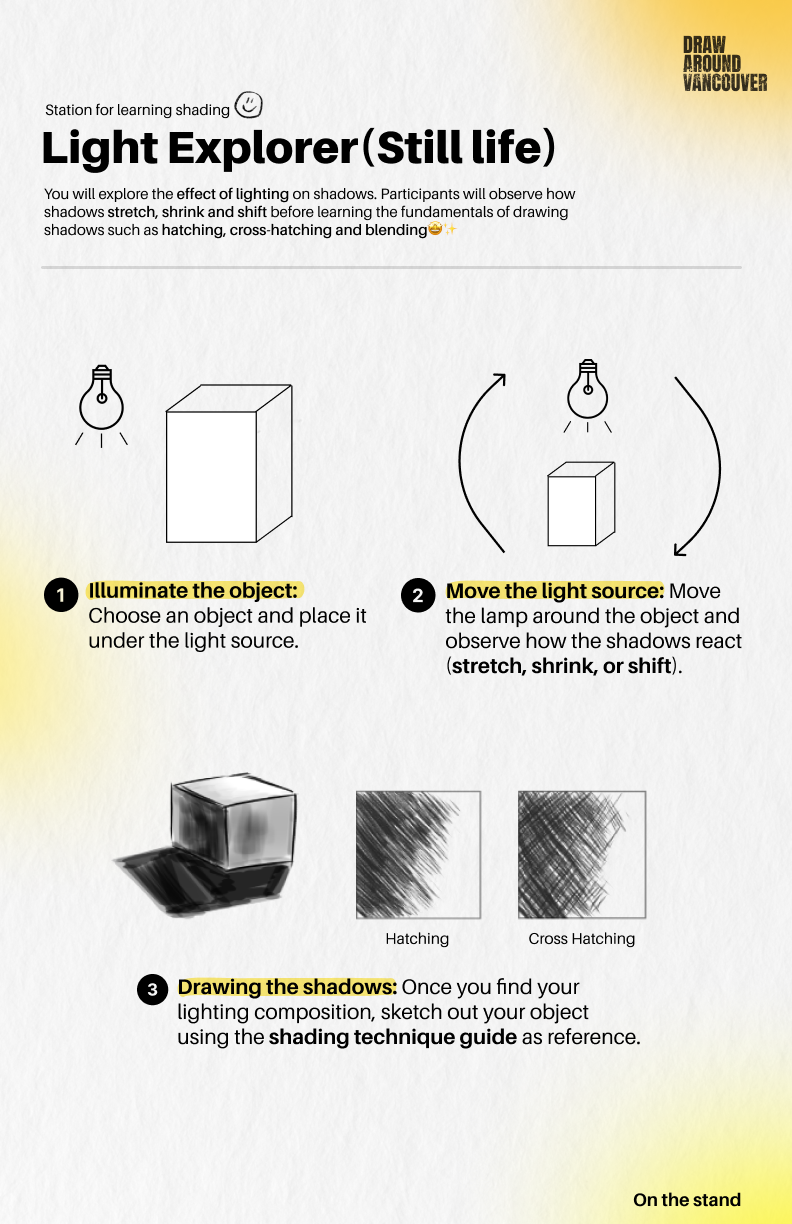

Alternate Activity: Light Explorer (Figure)
In this variation, participants explore lighting on a mannequin’s face to prepare for DAV’s life drawing sessions. Using a worksheet with faces shown at various angles, they reposition the light and observe the resulting shadows. Participants use reference guides to apply shading and repeat the process for different lighting scenarios.
- Skills: Lighting application in portraiture, shading realism
- Suggested time: 30 minutes
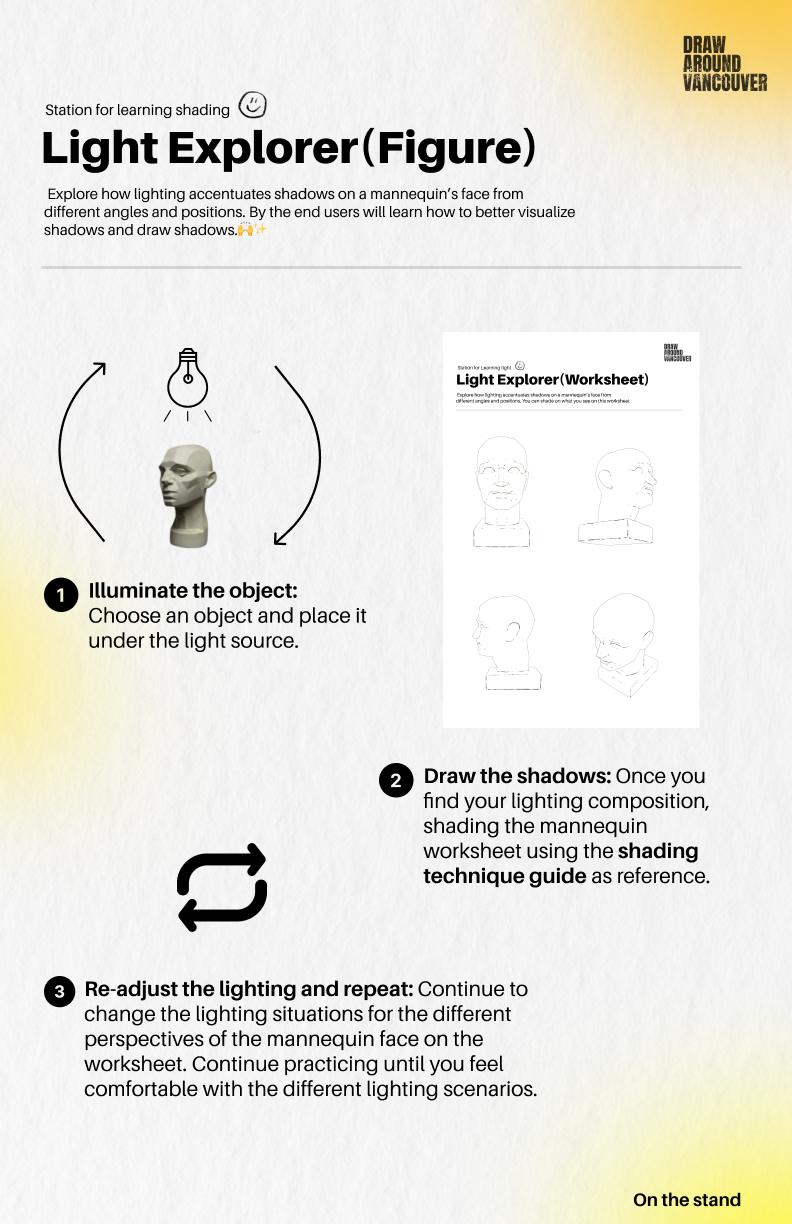
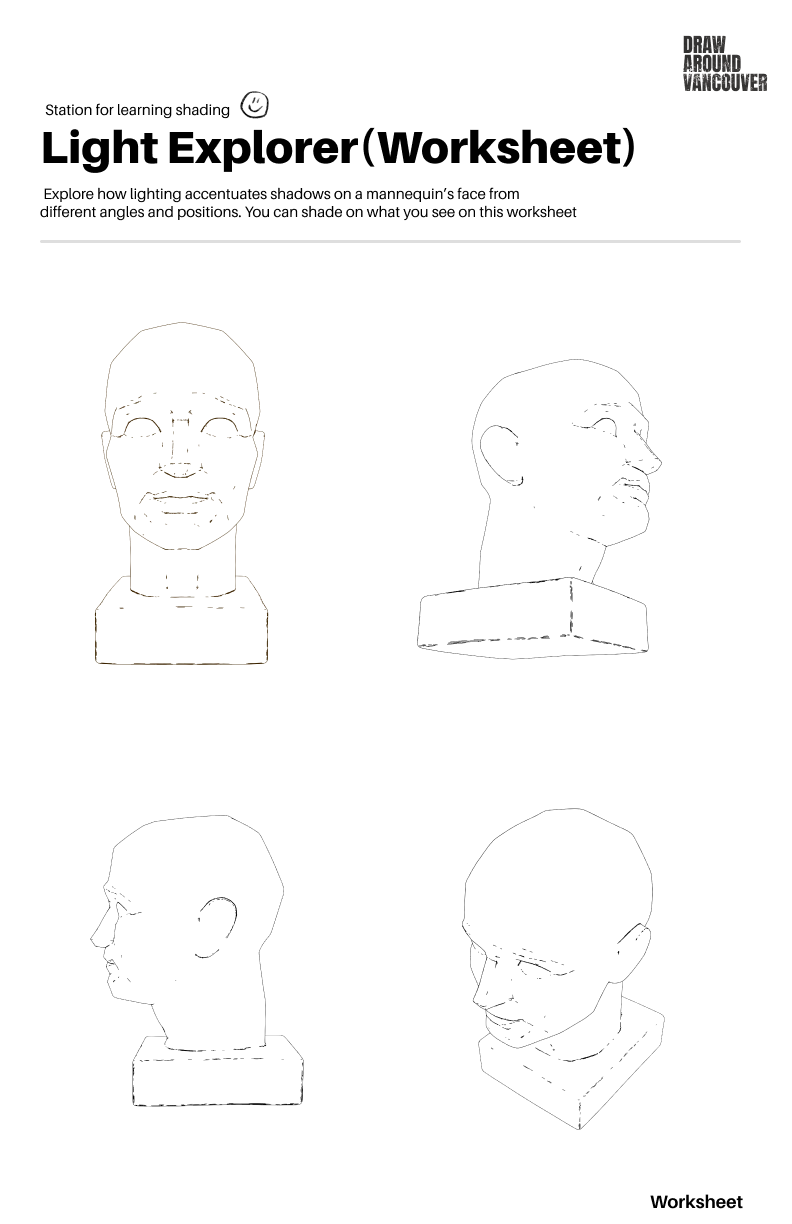
Station #3: Proportion & Perspective
Primary Activity: Square It Up
In this activity, participants use a transparent grid overlay to break down complex still-life compositions into smaller, more manageable sections. They sketch objects one square at a time, gradually building out their drawing while focusing on relative size and placement. This structured method encourages observation, comparison, and proportion accuracy.
- Skills: Proportional accuracy, grid-based drawing, visual comparison
- Suggested time: 30 minutes

Alternate Activity: Perspective Drawing
Participants select a graphical carbon sheet with perspective guides (one, two, or three-point), transfer the lines onto blank paper, and use them as a framework to create their own scenes. This helps them understand how vanishing points, horizon lines, and orthogonal guides work together to simulate depth and space in drawings.
- Skills: Perspective composition, spatial awareness, scene creation
- Suggested time: 30 minutes
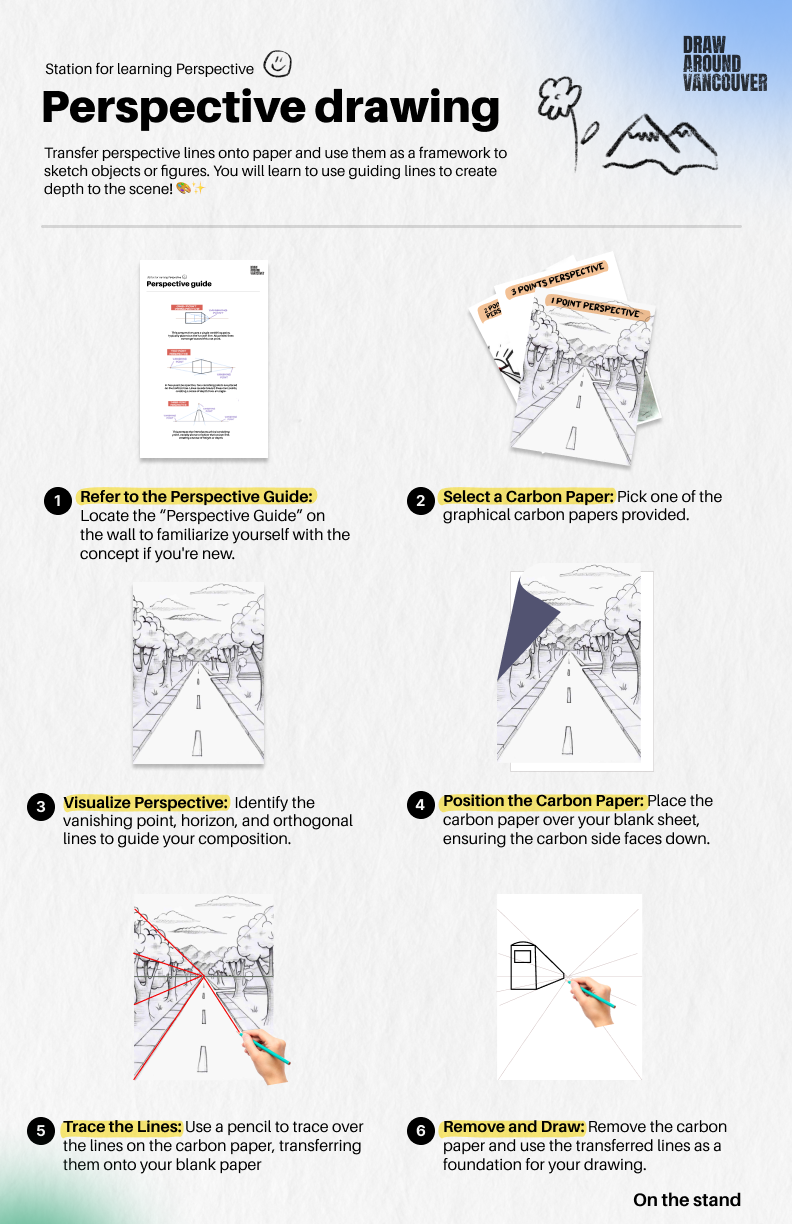
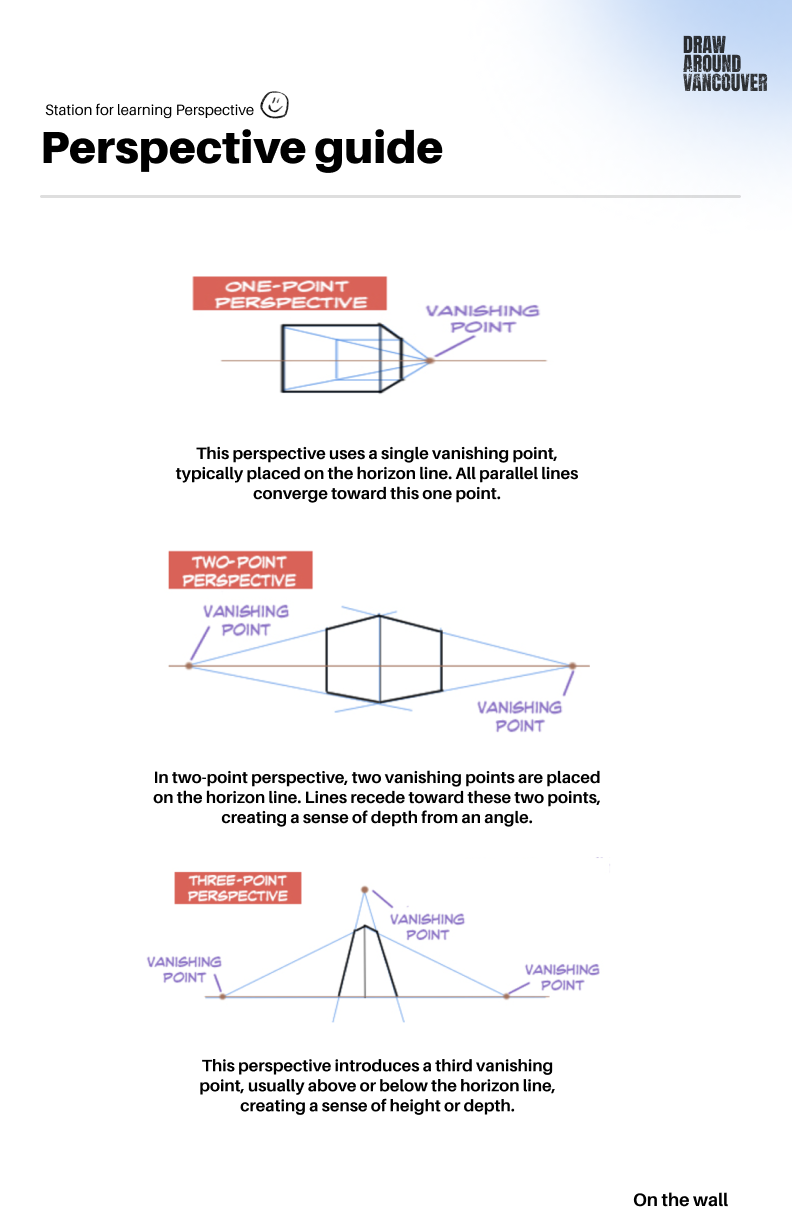
Station #4: Socialization
Activity: Coffee Corner
Coffee Corner is a relaxed and inviting space designed to encourage participants to share their artwork, connect with others, and take a break. Participants can unwind by sitting on comfortable chairs and enjoying small snacks and beverages. They can display their completed artwork from the session or previous sessions to receive feedback, using the provided sticky notes to exchange thoughts with others. Participants can also engage in a collaborative Exquisite Corpse activity, adding drawings to designated head, torso, or leg sections on the wall and seeing the creative combinations emerge.
Conversation prompts are available to help spark discussions about techniques, inspirations, and art journeys.
- Skills: Community building, reflection, informal critique
- Suggested time: Ongoing throughout the workshop
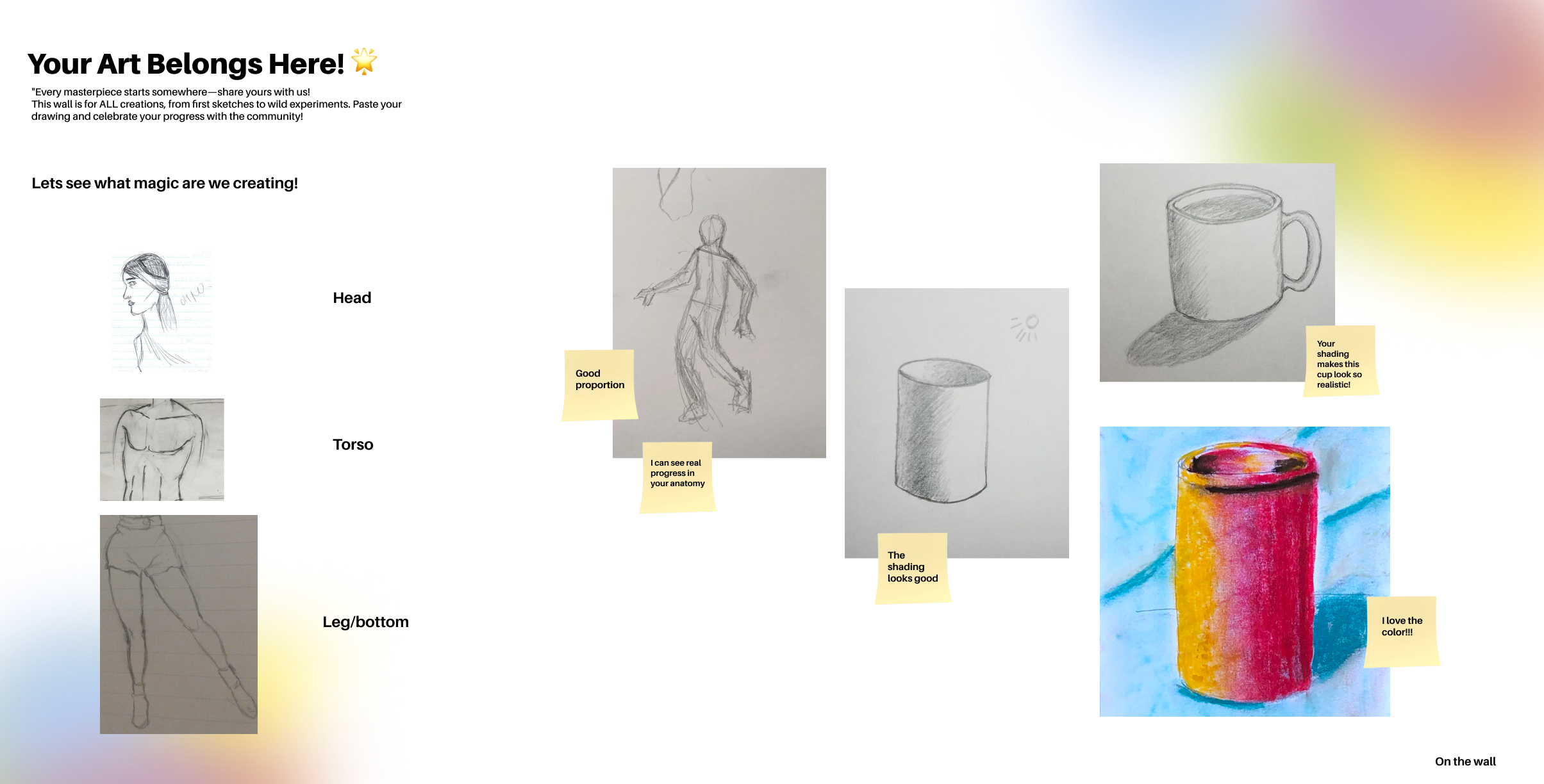
Concept Renders
As part of the final deliverable, our team created detailed concept renders to visualize the spatial flow and user interaction within The Drawing Arcade. These 3D illustrations, developed by one of our team members, helped communicate the atmosphere, accessibility, and structure of the experience in DAV's typical setting.
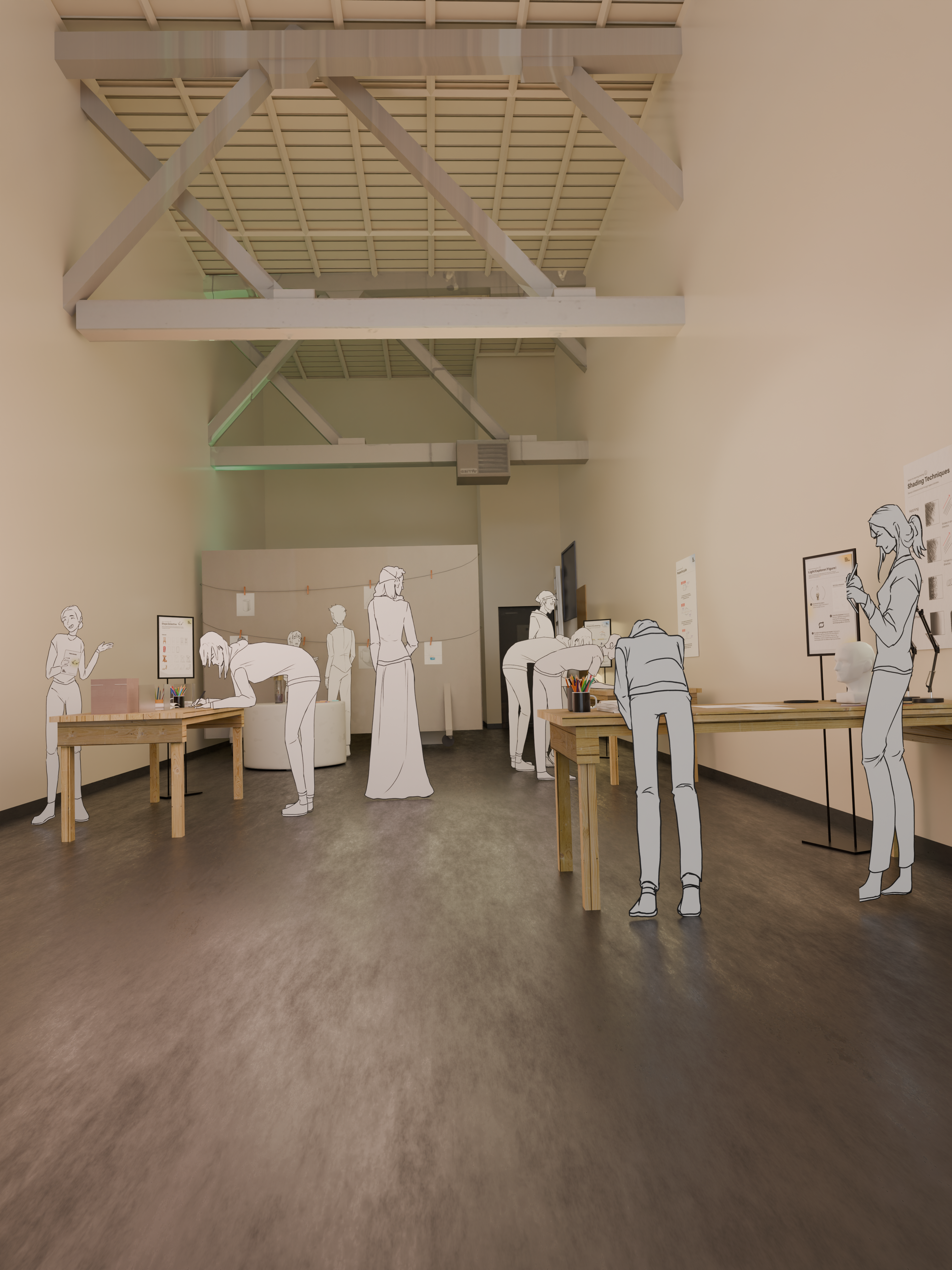
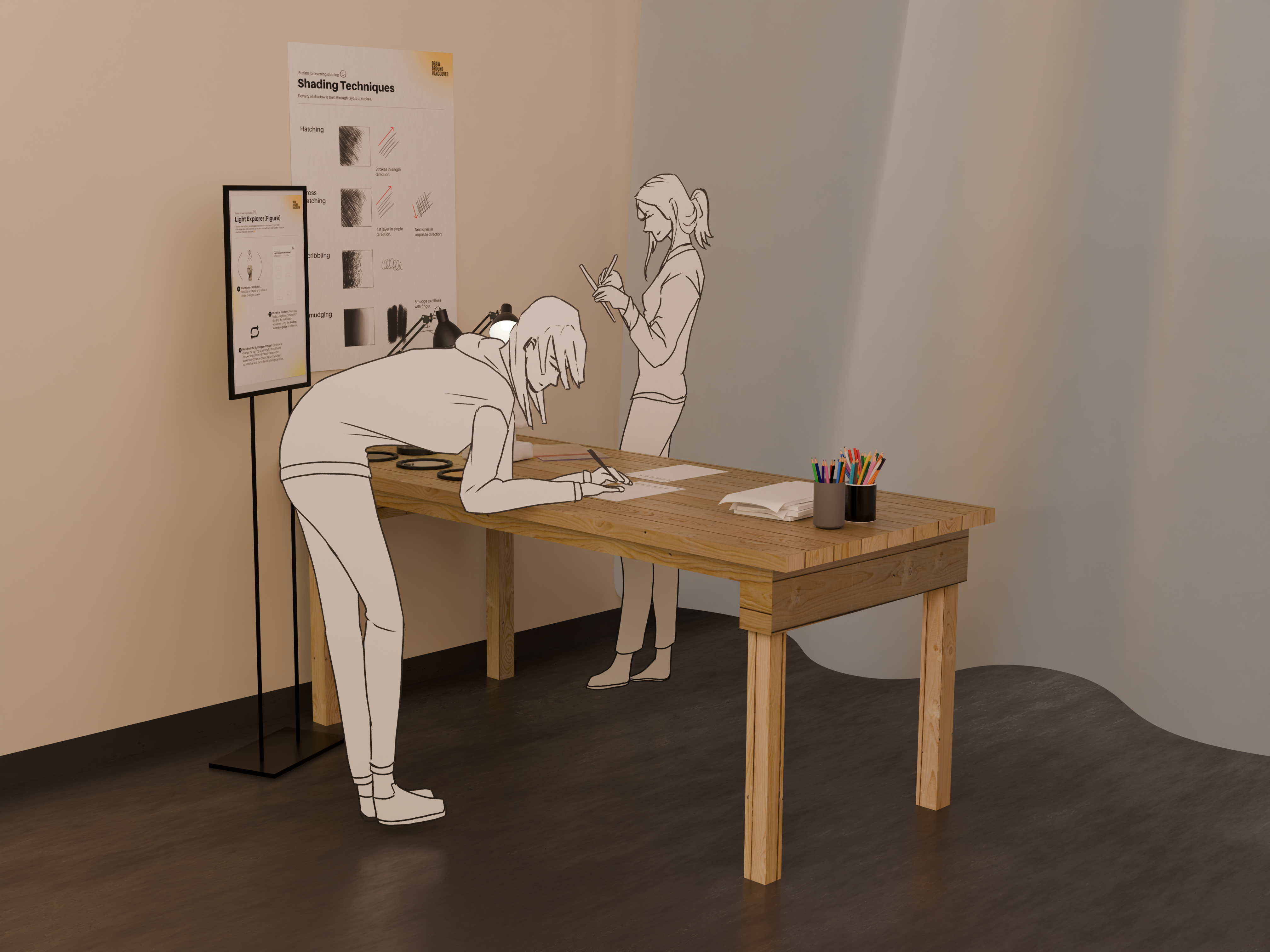
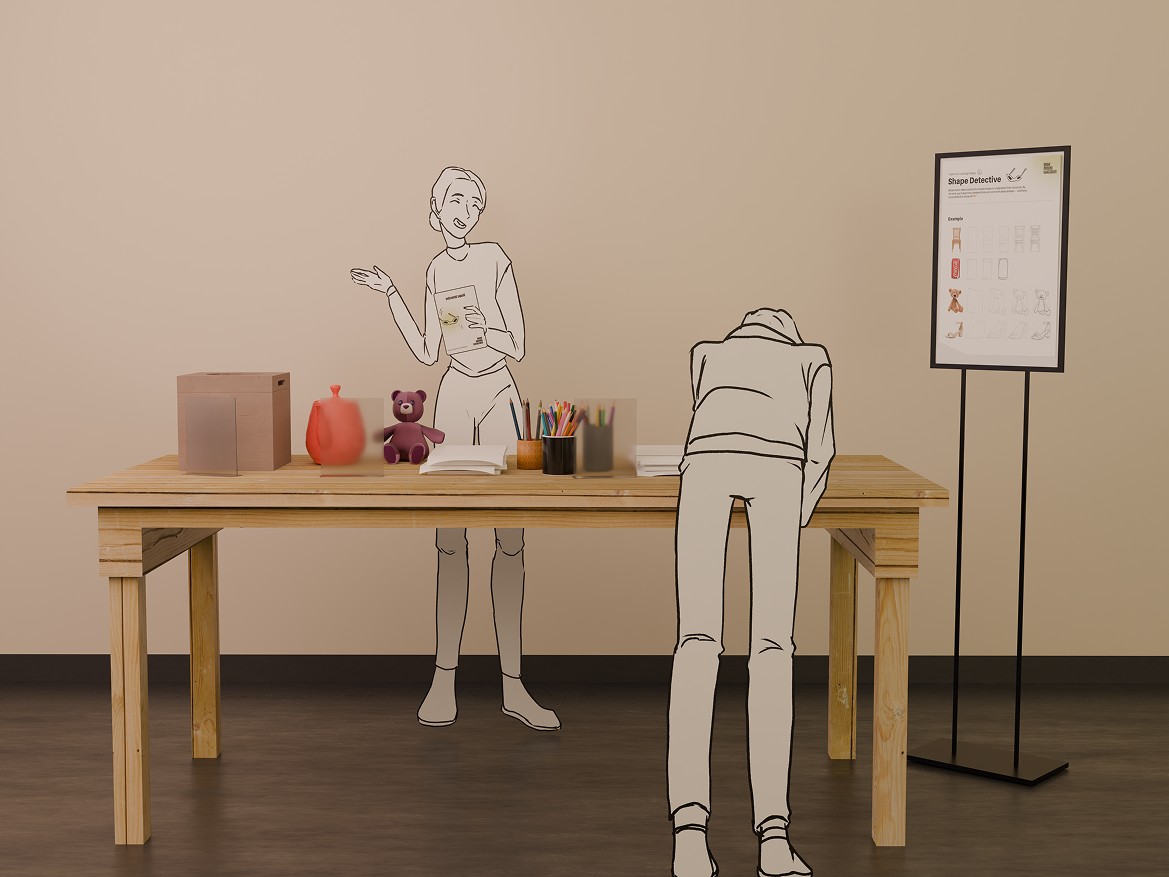
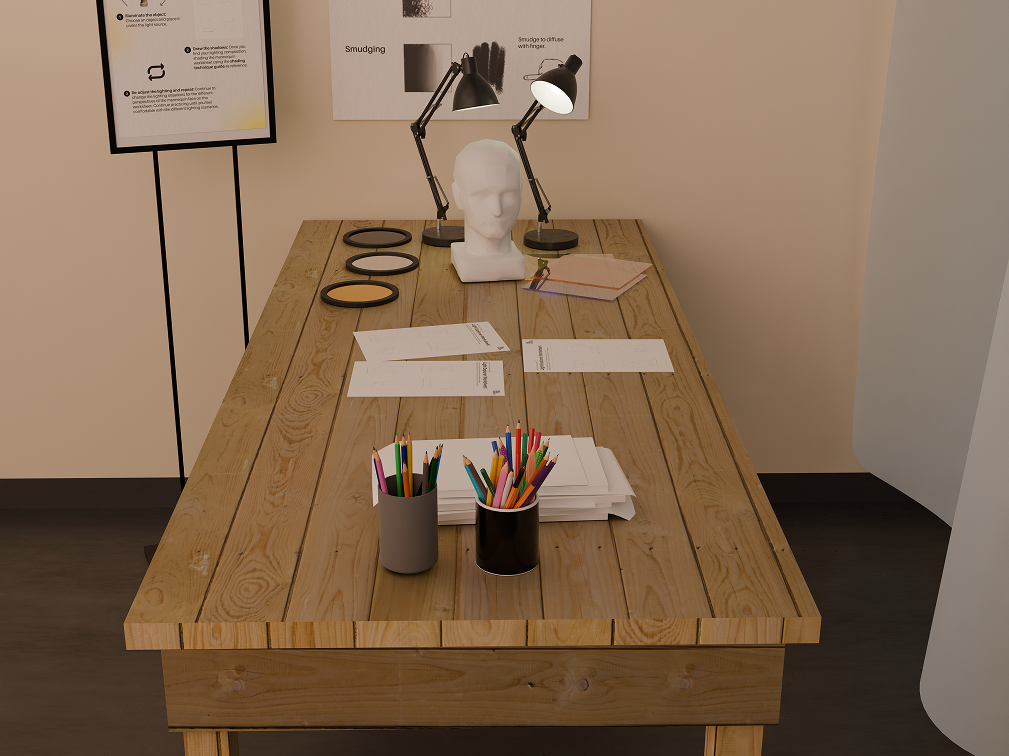

Design Effectiveness
While full implementation and quantitative impact measurements are still pending, initial qualitative feedback from both stakeholders and participants at Draw Around Vancouver (DAV) has been overwhelmingly positive. There is strong interest and willingness to integrate The Drawing Arcade into DAV’s recurring programming, signaling early validation of the workshop’s potential and its alignment with community engagement goals.
Reflection & Learnings
Outcomes of the Project
The DAV Drawing Arcade culminated in the successful design of a user-centered workshop experience that balances Draw Around Vancouver’s culture of free-form instruction with users’ desire for more progress-oriented guidance to boost their creative confidence. These dual needs were identified early through research and reaffirmed during iterative feedback sessions. The final station-based design received enthusiastic support and is now being considered for integration into DAV’s future LEARN sessions.
Personal Reflection
This project reminded me that UX is not always about giving users step-by-step instructions. Sometimes, it is about creating the right conditions for people to explore and build confidence at their own pace. Working on The Drawing Arcade taught me how to balance structure with freedom, especially when designing for individuals who may feel unsure of their creative ability.
Contributing to the planning and testing of our workshop activities helped me think more deeply about emotional design and how to reduce intimidation in social settings. I learned how small choices, such as a supportive prompt or an inviting setup, can transform a participant’s experience. These moments reinforced the importance of empathy, iteration, and adaptability in my design process.
This experience deepened my interest in designing creative tools and environments. I hope to continue building experiences that make people feel supported, curious, and capable.
Lessons Learned
- Talk to everyone involved in the process: Designing in a silo limits perspective. This project showed me the value of communicating with stakeholders, users, and teammates early and often to ensure that the design aligns with expectations and actual needs.
- Keep the user at the center: Grounding each decision in user research ensured our outcomes were not only functional but also resonated with real people. Empathy-driven design is now core to how I approach UX challenges.
- Design with constraints in mind: It’s easy to over-design when you're excited about solving a problem. I learned the importance of respecting the client’s operational realities, whether it’s time, resources, or team bandwidth, so the final product remains feasible and implementable.
These lessons don’t just apply to creative workshops or community art spaces; they’re transferable across a wide range of digital and in-person design contexts. Whether designing for online platforms, mobile interfaces, or service experiences, the core takeaways from this project, such as empathetic research, cross-functional collaboration, and designing within constraints, continue to shape my approach. Most importantly, this experience helped deepen my practice as a UX designer by reinforcing foundational skills in design thinking, strategic problem solving, and user advocacy.